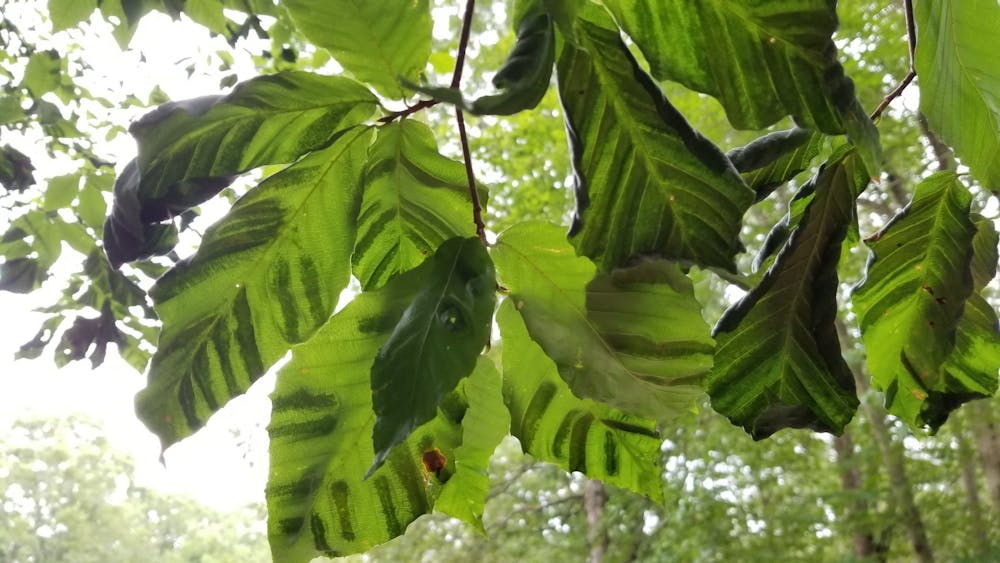American beech trees, present throughout Rhode Island’s forests and along the East Coast, are facing an existential threat.
Beech leaf disease will likely cause a “huge loss” to forests in Rhode Island and beyond, according to Heather Faubert, a research associate at the University of Rhode Island’s Plant Protection Clinic who also works for the university’s Cooperative Extension program. “Our forests have so many beech trees,” she said.
Faubert has identified the disease in multiple areas in the state, including the Arcadia Management Area in southwest Rhode Island and even a cemetery in Portsmouth. It has also appeared in other states such as Maine, Massachusetts and New York.
Initially discovered in Ohio in 2012, beech leaf disease is “very new,” according to Faubert. It first appeared in Rhode Island in 2020 and Providence county only last year.
The disease is caused by a foliar nematode — a microscopic, worm-like organism that lives within the leaves of a plant — that affects the plant’s buds. When the leaves emerge in the spring, they are damaged and have darker green stripes between their veins. Severe damage comes in the following years, when the leaves eventually become crinkled and leathery, eventually falling from the tree.
“Last year, we were seeing a whole lot of trees, especially in southern Rhode Island … that were defoliated by the end of May, or the leaves wouldn’t even emerge,” Faubert said. In addition to cutting off a tree’s ability to photosynthesize, defoliation forces it to expend energy creating new, smaller leaves, weakening the tree and making it more vulnerable to other diseases.
While many American beech trees in the region remain in the forest understory, one place in Rhode Island — the Aquidneck Land Trust Oakland Forest and Meadow — is home to 20 acres of old-growth beech trees, according to its website. The Oakland Forest is an extremely rare type of habitat, especially for southern New England, according to Sean Grandy, stewardship manager at the Aquidneck Land Trust. The forest has also been infected with beech leaf disease, he said.
Last summer, the canopy was noticeably thinner and not as shady due to the affected trees losing their leaves, Grandy said. The organization has applied experimental treatment to some of the forest’s beech trees, with hopes to expand the effort. But trying to treat a whole forest is expensive and labor-intensive, he explained. The Trust’s new forest management plan includes planting more oak trees and beyond that, waiting for new research on the subject.
A species dying on such a large scale changes the structure and habitat of forests, according to Rebecca Kartzinel, lecturer in biology, lecturer in ecology, evolution and organismal biology and director of the Brown University Herbarium. “Never mind if that particular species is functionally replaceable — you’re ultimately reducing diversity.”
Faubert compared the disease to chestnut blight, a fungal disease that killed nearly all of the chestnut trees on the East Coast in the early 20th century. Kartzinel also pointed to Dutch elm disease, which devastated both forest and street trees in the 20th century. “I feel like we’ve learned our lesson,” Kartzinel said. “Imagine walking through (a forest) seeing stands of just dead trees.”
But in contrast to chestnut — a “very important wood” — American beech wood is not typically used for building and furniture, Faubert said. “They’re not appreciated as much.”
While Rhode Island’s Division of Forest Environment informs arborists and forestry consultants about the disease, the state “doesn’t have funding for large-scale treatments of forest pests,” according to Nancy Stairs, cooperative forestry program supervisor at the Rhode Island Department of Environmental Management.
Beech leaf disease “does affect what our future forests may look like,” Stairs said. “There’s just not anything in Rhode Island or other states that can be done on a larger scale forest response at this time.” She added that the department will continue to monitor the disease’s spread and pay attention to developing research on the subject.
American beech are mostly present in Rhode Island’s forests, but there are lots of “big, beautiful European beech trees … in the city” that can also be affected by beech leaf disease, Faubert said.
Kartzinel noted that European beech trees are part of the “urban landscape,” making up many of the street trees in the area.
American beech is Faubert’s favorite deciduous tree, she said. Younger beeches retain their leaves through the winter, flaunting a light brown color that is “very, very pretty.” The spread and damage of beech leaf disease, she added, is “heartbreaking.”
“Yeah, I feel like our forests are doomed,” she said. “And I hope I'm wrong.”
Haley Sandlow is a contributing editor covering science and research. She is a junior from Chicago, Illinois studying English and French.





